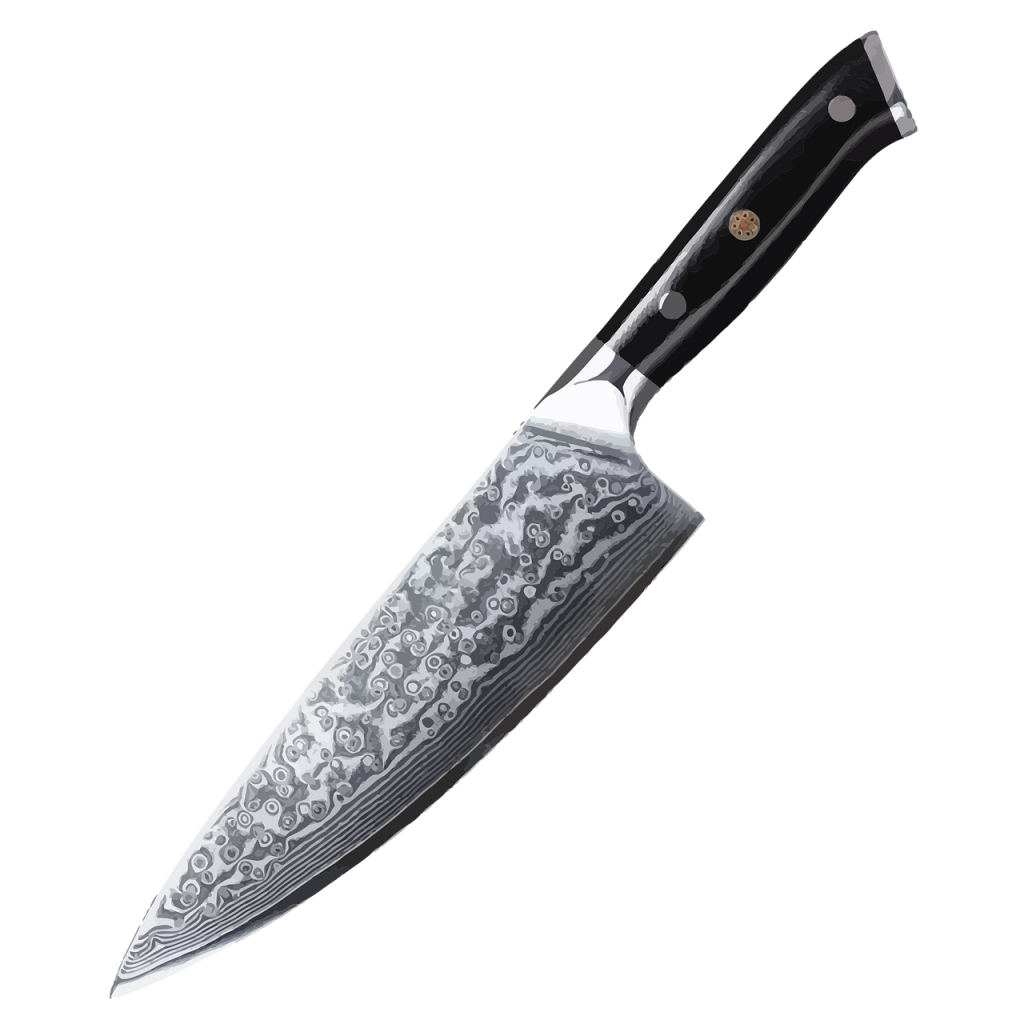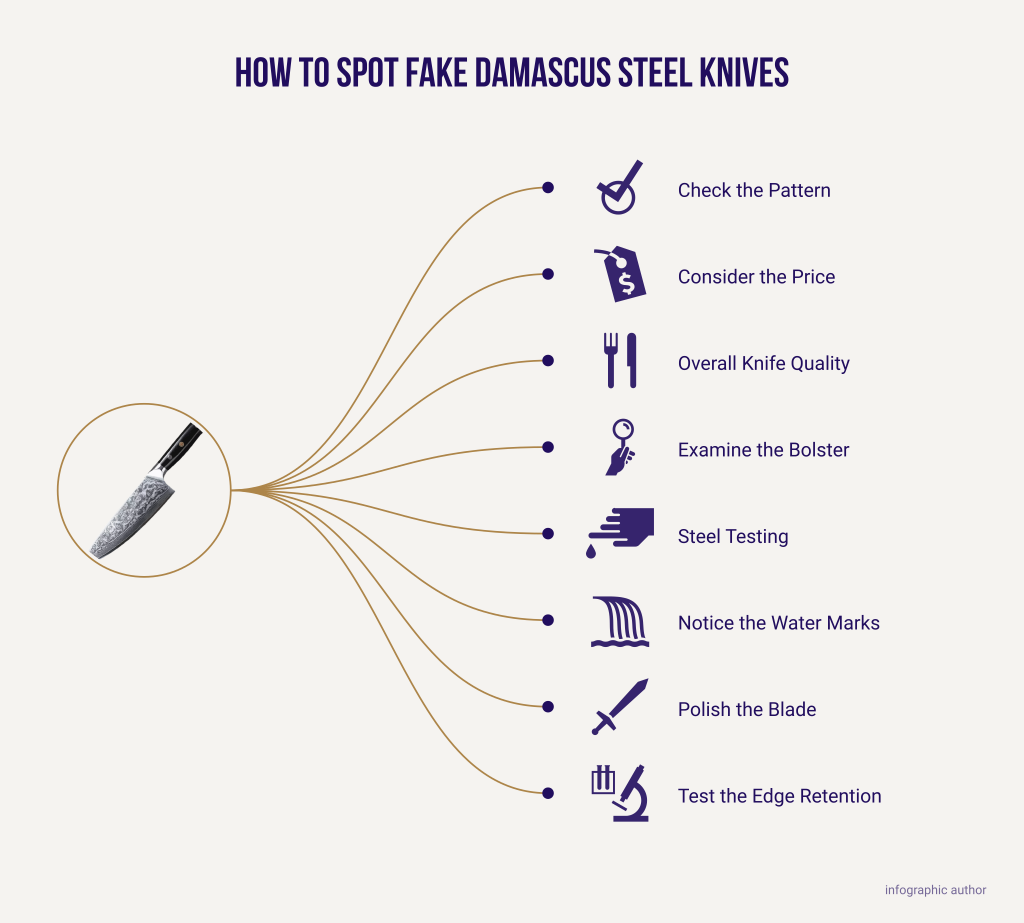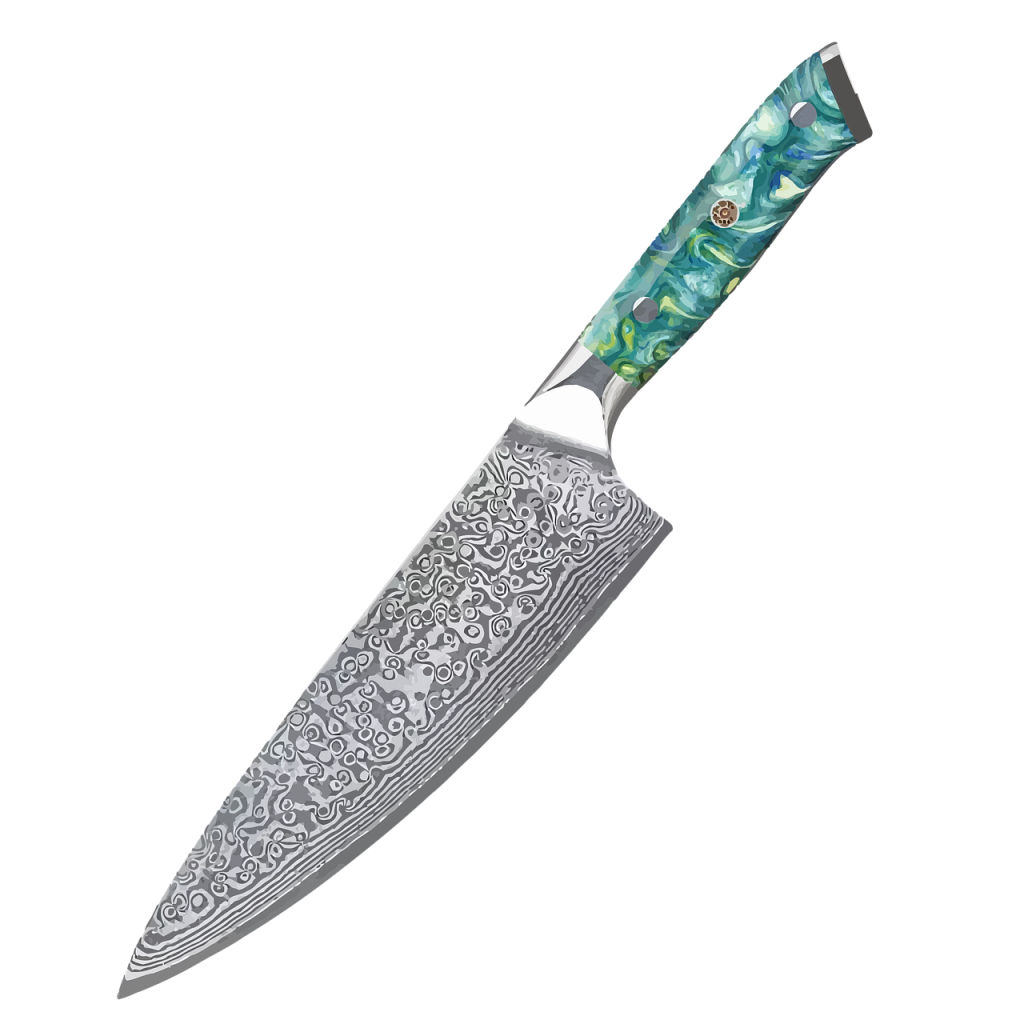You’re perusing an online marketplace or browsing in a store, and you find the perfect knife. It’s got a beautiful, intricate Damascus steel blade, and it’s calling your name. But do you know how to spot fake Damascus steel knives?
Unfortunately, many evil people are out there selling fake Damascus steel knives. You may have even found what you were looking for, but there’s one problem: you’re not sure if it’s the real deal. In this guide, we’ll show you how to spot a fake so that you can avoid scams.
What are Damascus Steel Knives?

At first glance, Damascus steel knives look like any other high-quality kitchen knife. But upon closer inspection, you’ll notice that the blade is full of a beautiful, intricate pattern. This pattern is known as the Damascus effect, and it’s created by folding and forge-welding multiple layers of steel together.
Damascus steel is a strong, durable type of steel that gets its name from the city of Damascus in Syria. People first used it to make swords in the Middle East during the medieval period. Today, craftsmen commonly use Damascus steel to make knives due to its slenderness, hardness, and edge retention.
Damascus steel knives are prized for their unique patterns, created by the layers of metal in the blade. No knives are exactly alike, making them a popular choice among collectors and knife enthusiasts.
Ways for Constructing Damascus Steel Knives
Three main methods for constructing Damascus steel knives are forging Wootz, pattern welding, and acid etching.
✅Wootz Damascus Steel
The technique used for making Damascus steel in India was around two thousand years ago. Wootz steel ingots were then sent to Damascus, Syria, where the locals hammered them into swords. The blades were praised for their strength and physical ability.
The wootz ingots were melted down with other materials, including wood chips, to produce a crystalline material rich in carbide. Carbides are compounds formed when carbon latches onto another element, resulting in harder steel. Depending on the heating technique used, it can create different carbide structures. These different structures result in different carbide structures that can greatly impact a blade’s performance.
Some researchers have claimed that the micro-segregation process can reproduce Wootz Damascene steel blades. This process involves the micro-segregation of the minor carbide-forming elements in the Wootz ingots. This phenomenon can produce the distinctive metallurgical microstructure found in Wootz Damascus blades.
The microstructure of wootz Damascene steel blades is from bands of iron and carbon particles (FEC) arranged along a centerline. This pattern is also called the rose pattern. The blades have band spacing in the range of 40-50 mm.
✅Pattern-Welding Steel
Nowadays, Damascus is known as this. It comprises 99.9% of all visible Damascus steel.
This process includes bringing together two or more complementary kinds of steel once forged together. Some acid etching then amplifies the variations in the steel. As a result, it produces a wavy pattern that nearly mimics the ancient Damascus.
Before becoming single-handedly revived in the 1970s by the brilliant Bill Moran, pattern-welded steel went out of favor for generations.
Additionally, you may sometimes encounter knives marked “VG-10 Damascus.” Damascus steel is on each side of a VG-10 core. Three layers of steel are placed together to form the San Mai mold, which laminates the steel.
✅Acid Etching Steel
The last method used for creating Damascus steel knives is acid etching. This process involves using a corrosive liquid to expose the layers of metal in the blade and create patterns similar to those found in authentic Damascus steel knives. The most popular acids used for this process are nitric, hydrofluoric, and sulphuric.
What Are Fake Damascus Steel Knives?
Real Damascus steel takes a long time to create, and the blade benefits from its unique properties after finishing it.
Due to the time required to produce the steel, the superior steel used in Damascus, and the improved blade endurance, true Damascus blades are more expensive.
Shady knifemakers and suppliers try to profit from the demand for Damascus steel knives by covering one steel blade with Damascus-like designs. By providing a subpar product and using deceptive marketing, they ultimately scam the buyer by charging more for the phony Damascus.
Both forging wootz steel and pattern welding have used acid etching to highlight the water and twist designs in the Damascus knives. Some knifemakers, however, mimic pattern welding by acid or laser etching stainless or carbon steel blades.
These are recognized as fake Damascus steel since their primary purpose is to artistically stamp Damascus-looking patterns on less expensive knives. They lack the intrinsic characteristics of a blade made of Damascus steel.
How to Spot Fake Damascus Steel Knives

Regarding kitchen knives, there is no shortage of options on the market. It can be hard to know where to start with many different materials, designs, and manufacturers. Damascus steel is a great option if you’re looking for a high-quality knife that will last a lifetime.
However, with the popularity of this material, there are also a lot of fake Damascus steel knives out there. Here’s how to spot them.
🔪Check the Pattern
The first item you should look at is the blade’s Damascus pattern. The knife could not be authentic if the Damascus pattern patterns don’t seem natural and are highly intricate or complex.
Real Damascus designs are gorgeous and one-of-a-kind, yet they always develop due to Damascus steel’s inherent folding. Genuine chef knives made of Damascus steel contain steel fold patterns consistent with classic patterns like raindrops, watery, wavy, feather, ladder, twist, etc.
Authentic Damascus steel often has a distinct etching that is uniformly apparent across the blade and always readily visible. You most certainly have a phony knife if the etching seems to be false or is hardly visible.
🔪Consider the Price
Genuine Damascus steel knives are expensive. If the price of the knife is too good to be true, it’s probably a fake.
Forging and folding Damascus steel takes several hours and requires services from highly skilled blacksmiths. As a result, you can expect that real Damascus blades will cost significantly more than standard stainless-steel knives.
These are certainly not surefire techniques to identify fake Damascus, but they are all warning signs that should cause you to think twice before clicking the “purchase” button.
🔪Overall Knife Quality
Take a closer look at the overall quality of the knife. Although fake Damascus knives may have a nice Damascus pattern etched on them, they often lack good craftsmanship and quality materials. Damascus steel blacksmiths often make considerable effort to create blades that meet the highest standards of excellence.
A well-made, genuine Damascus steel knife should be sharp enough to cut through any food but resilient enough not to chip easily. Check the construction of the blade and how it interacts with its handle.
If it feels unsteady, or if you feel like the handle would easily come apart from the blade, then chances are high that it’s a fake Damascus steel knife. Real Damascus knives have unique patterns and also feature superior construction quality.
🔪Examine the Bolster
Real Damascus knives feature a bolster, the curve between the handle and the blade. It should be seamless and flush to ensure that food particles don’t get stuck. These are signs of inferior-quality construction if you observe gaps or irregularities between the blade and handle.
Inferior fake Damascus knives often have an abrupt transition between the blade and handle rather than a gradual curve. The bolster on genuine Damascus blades is formed from copper or brass, whereas the bolster on imitation knives is aluminum or stainless steel. Keep this in mind as you examine how well the bolster is constructed before purchasing.
🔪Steel Testing
The final way to spot a fake Damascus steel knife is by testing the steel. However, most individuals find this to be a challenging, costly, and complex procedure to obtain. The crucial point, in this case, is that although imitation knives may imitate the design and presentation, the composition is completely different.
Real Damascus steel should not attract a magnet. However, imitation knives made of steel alloys will be attracted. Using a magnet on the blade is a straightforward way to tell if you have an authentic Damascus steel knife or a knockoff. However, it’s important to note that this isn’t a 100% reliable test, as some Damascus steel alloys attract magnets but are still genuine.
🔪Notice the Water Marks
Searching for watermarks is another method of determining whether a blade of Damascus steel is authentic. Typically, these etched spots are left over from the acid-etching procedure that provides Damascus its unique appearance.
Authentic Damascus steel will have small faint watermarks visible when you look closely. A real Damascus steel knife should feature a unique and intricate pattern across its length. Different etches or waves should run parallel throughout the blade in a swirling motion. The presence of these watermarks can be an indication that the blade is real Damascus steel.
The blades of genuine Damascus knives should be able to take on a bluish watermark after being dipped into acid. It is due to the process of forging and folding the steel multiple times, which gives it an intricate pattern that reacts to acid differently than other metals. If you don’t see any reaction when you dip the blade in acid, it’s likely a fake Damascus steel knife.
🔪Polish the Blade
Polishing a portion of the blade until the pattern is invisible is another technique to determine whether the steel is genuine Damascus. Then it would be best to soak the blade in an acidic solution. The pattern won’t show up if you have fake Damascus steel. Yet, if the pattern returns after you polish it and dips it in an acid bath, you have a genuine Damascus steel blade.
🔪Test the Edge Retention
A blade made of real Damascus steel will have a razor-sharp edge that won’t shatter or crack. Additionally, it will maintain its sharpness for a long time, even if you use it frequently. If the blade’s edge is chipping or turning dull quickly, then this could indicate that your Damascus steel knife is not authentic.
Damascus Steel Knife Maintenance Guide

You’ve just invested in a beautiful Damascus steel knife. Congratulations! With proper care, your knife will age gracefully and provide you with years of enjoyment. Here are some tips to help you keep your knife in top condition.
📌Keep it clean and dry.
After each use, wash your knife with warm, soapy water. Be sure to rinse it thoroughly to remove all traces of soap that can damage the blade. Use a soft cloth or sponge to avoid scratches. Then, dry your knife immediately with a clean towel or air dry it. It’s important to keep the blade clean and moisture-free to prevent corrosion.
📌Store it safely
When you’re not using your knife, store it in a safe place where it won’t get nicked or scratched. A kitchen drawer is a good option, or you can purchase a magnetic strip for easy, accessible storage. If you’re traveling with your knife, pack it securely in a hard-sided case to protect it from damage.
📌Avoid abrasives
Never use abrasive cleaning products or harsh scrubbers on your Damascus steel knife. These can remove the patina and damage the finish of the blade. Instead, stick to warm water and a soft sponge to keep it clean and safe.
📌Honing rod
Be sure to use a honing rod made of soft steel, ceramic, or diamond–harder materials can damage the blade. Hold the rod at a 20-degree angle to the blade and draw down the rod’s length towards you. Repeat on the other side of the blade until you’ve honed the entire edge evenly.
📌Don’t use it for everything.
While Damascus steel knives are incredibly versatile, they’re not indestructible. To prolong the life of your knife, avoid using it on hard surfaces like tile or glass cutting boards, chopping through bones, or prying open cans or jars. When in doubt, avoid caution and reach for a different kitchen tool.
📌Have it professionally sharpened when needed
Although you can sharpen your knife at home (see tip #3), leaving this task to a professional when possible is best to ensure that you properly care for the blade. A professional knows how to sharpen all types of blades without causing damage.
Frequently Asked Questions
Why is the Damascus pattern not visible everywhere?
The Damascus pattern may not be visible in the blade’s spine, bolster, or tang. These areas are usually grounded during the forging process to create a stronger and sturdier knife. Another reason is that you may polish off the design after certain places are etched, so it is not apparent.
Does Damascus steel rust?
Damascus steel can rust if it is not properly cared for and maintained because of its high carbon content. On the contrary, stainless Damascus steel is so-called for a reason. It contains a high amount of chromium, which makes it resistant to corrosion and rust.
Keep the blade clean and dry after each use, store it safely, and avoid abrasive cleaning products that can remove the patina. Additionally, regularly honing and sharpening your knife will help prevent corrosion.
Why are there so many fakes Damascus?
Damascus steel is in high demand due to its appeal, but the manufacturing process is costly and time-consuming. Consequently, several producers are trying to economize by producing imitation Damascus steel blades.
What are the benefits of owning a Damascus steel knife?
Damascus steel is known for its strength and durability, making it an ideal choice for a kitchen knife. It also has a beautiful pattern that adds to the aesthetic appeal of the blade. Damascus steel is less susceptible to corrosion and scratches than other knives.
How many layers must Damascus steel have?
To be classified as Damascus steel, the blade must have at least two layers of steel forged together. However, some high-end knives have 300 to 500 layers, which gives them a unique pattern and increased strength.
How often should I sharpen my Damascus Steel knife?
It’s best to sharpen your Damascus steel knife when it feels dull. It’s also important to use the proper tools and technique for sharpening, as this will help maintain the blade’s beautiful pattern and keep it from becoming damaged. If you don’t use your Damascus knife every single day, you must oil the blade once a month and after each usage.
Final Words
Damascus steel is an exquisite material used to craft knives for centuries. With the proper care, these blades can last a lifetime and provide unparalleled performance in the kitchen. While it’s relatively easy to spot fake Damascus steel, it’s best to purchase from reputable sources if you want the highest quality blade.
To spot fake Damascus steel, look for inconsistencies in the pattern, check how many layers of steel have been used, and inspect how sharp the blade is. Additionally, be wary of Damascus blades that are too cheap and don’t feel high-quality. With some research and care, you can easily find a genuine Damascus steel knife to suit your needs!
